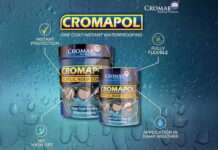A leaky shed roof isn’t just annoying—it’s a disaster waiting to happen. Whether it’s your tools, garden furniture, or a prized collection of random bits and bobs, you need your shed to stay watertight.
That’s where shed felt and adhesive come in, offering a simple, cost-effective way to weatherproof your roof.
The UK gets an average of 133 days of rain a year – that’s a lot of water threatening to sneak into your shed. But don’t panic—learning how to use adhesive with shed felt is easier than you might think, and it’ll give your shed the protection it needs to survive our famously soggy climate.
In this guide, we’ll walk you through everything you need to know, from choosing the right adhesive to applying it like a pro. Let’s get that shed roof sorted, shall we?
What is Shed Felt Adhesive?
Shed felt adhesive keeps your shed’s roof firmly in place, whatever the weather has in store. Adhesive is bituminous. In other words, it doesn’t just stick things together. It seals, offering a double defence against wind and rain.
Great for reinforcing critical overlaps and edges, shed felt guarantees your roof’s felt stays put and leak-free.
Shed felt adhesive isn’t just a one-trick pony. For instance, products like Cromar’s Roofing Felt Adhesive shine if you pair them with felt shingles, which are layered by design. It isn’t purely for shingles, though. You can use it for regular shed felt, too.
Roofing Felt Adhesive or Nails?
When it comes to securing shed felt, nails are the traditional choice – quick, easy, and they get you out there building faster than you can say ‘DIY’.
But here’s where adhesive comes in. It adds that extra layer of security and waterproofing that locks down the felt.
Plus, on windy days, you’ll thank the sticky stuff for keeping everything snug.
So, why not give your shed the best of both? Use nails for that solid hold, and follow up with adhesive for the ultimate weatherproof seal.
Explore our shed felt products to get started on your project.
How to Apply Shed Felt Adhesive?
Fancy giving your shed roof a waterproof renovation? Applying shed felt adhesive is straightforward but entails a little elbow grease and some attention to detail. Check out these steps to keep your shed cosy and dry.
Step 1: Prepare the Materials
First things first, get your toolkit sorted.
You’ll need:
- Your chosen shed felt adhesive (make sure it’s suitable for outdoor use)
- A sturdy paintbrush or roller for application
- A pair of gloves to keep your hands clean and protected
If the weather’s cold, remember to keep that adhesive warm before use. It spreads easier when it’s not cold.
Don’t forget to check out our ladders to safely reach every part of your shed roof.
Step 2: Choose the Right Roofing Felt
Not all shed felts were made the same. You have a few options from the basic all-weather types to the fancy UV-resistant varieties.
Think about where your shed’s placed and what it’s up against—sun? Rain? The neighbour’s footballs?
Choose a felt that stands up to your specific challenges to ensure your shed’s roof remains unbroken and effective.
Find various options in our roofing sheets section.
Step 3: Measure and Cut the Shed Roofing Felt
Now, roll out your felt and measure up. You want enough to cover the entire roof with a decent overlap at each edge to prevent leaks.
Use a sharp utility knife for cutting. Crisp edges make for a cleaner, more professional finish.
Accuracy now prevents headaches later.
Check out more roofing materials like roof shingles for alternative coverage options.
Step 4: Apply Shed Roof Adhesive
Time to get sticky.
Slather a generous layer of adhesive onto your prepared surface using your brush or roller.
Aim for even coverage. No skimping, as this glue is what keeps everything tight and tidy.
Give it a moment to get tacky before the next step.
Step 5: Lay Down the Roofing Felt
Carefully align your felt at one end of the shed roof. Press it into the adhesive. If you’re layering multiple sheets, start from the bottom up. You want each one to overlap the last for maximum water resistance.
Smooth it out to avoid any air pockets or wrinkles.
Step 6: Firm Up the Edges
Now your felt is in place, it’s time to bolt it down. Hammer in some galvanised nails along the edges of the felt at regular intervals. Make sure they’re spaced closely enough to hold the felt firmly against any blustery days.
Step 7: Overlapping and Sealing
Overlap sections by at least 3-4 inches to guard against water ingress.
Apply a line of adhesive under each overlap then press firmly to bond the layers together.
This step is imperative. Proper overlapping acts as a barrier and keeps moisture out and warmth in.
How to Use Adhesive with Shed Felt
Think using adhesive with shed felt just involves applying some glue and calling it a day? Not the case.
Start with a clean, dry surface and choose a day with good weather to ensure the adhesive sets well.
Apply the adhesive evenly, lay the felt carefully, and ensure all overlaps and edges are securely glued and nailed.
This method means your shed roof will last a lot longer. It’ll withstand even the severest of weather conditions. After all, a well-applied adhesive strengthens the felt’s grip and boosts its waterproofing capabilities, no end.
Need specific product recommendations? A bit more guidance? Pop over to our contact page or check out our range of shed felt and adhesives.
What Do You Stick Shed Felt Down with?
Aside from using specialist shed felt adhesive, you can also secure your shed felt with galvanised clout nails.
These nails are brilliant for withstanding the elements, so your felt stays put through wind and rain.
Do You Need Adhesive for Shed Felt?
Adhesive isn’t always essential, but it gives an extra layer of security against leaks, especially in windy areas or in high-exposure sheds.
For best results in harsh weather conditions, combine adhesive and nails. This will keep your felt more secure.
The Takeaway
And that’s that. Securing your shed felt is super-important to protect your outdoor oasis from the volatile British weather.
Whether you go for adhesive, nails, or both, having it installed correctly means your shed stays dry and protected year-round.
Need supplies or advice? Head over to our website or contact us directly for all your roofing needs.





